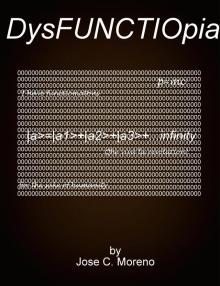- Home
- Jose Moreno
DysFUNCTIOpia
DysFUNCTIOpia Read online
DysFUNCTIOpia
by
Jose C. Moreno
Edited by Jose C. Moreno
Copyright 2013 Jose C. Moreno.
’DysFUNCTIOpia’ created by Jose C. Moreno.
All rights reserved. No part of this publication may be reproduced or transmitted by any means, without the prior permission of the author.
This is a work of fiction. Characters are fictitious. Any resemblance to an actual person, a specific institution, or an event is entirely coincidental.
INTRODUCTION
Although this book might be attractive to young readers, it also presents mature political and philosophical issues, in symbolic form, related to education, democracy, and technology.
One of the purposes of this book is to question the relation of humans and technology. The growth of technology seems to be the fate of humans. The central question in this book is, “how can humans find contentment in their lives in the midst of fast technological changes?”[1]
“DysFUNCTIOpia” is a world where complex technology infringes on some individuals self-image by not giving those individuals the ability to form a meaningful relation with that technology due to their unexpected social consequences; In other words, technology has become an end in itself without regarding its connection to humans. As a result, democracy becomes dysfunctional.
On the other hand, this book is an invitation to see the “spiritual” value in technology. One of the main messages of this book is that, even in a technocracy, one could still find life meaningful. “DysFUNCTIOpia” illustrates a psychological process for affirming a technocracy.
Nevertheless, this book also introduces possible technological implementations that are actually under development or could happen in the future. At the end, a glossary of the fictitious technological implementations is presented; those fictitious implementations have been underlined throughout the book. References and notes are included so that that they can enlighten technical readers; however, it is not necessary to read the references to understand the book. In some of the technology introduced, the author emphasizes the roles that electromagnetism and quantum mechanics could play in the future. Propulsion by means of “electromagnetic pressure”[2], vandalism of computer systems by means of electromagnetic radiation, and quantum computers[3] are examples of that. The author tried as much as possible to conceive a future where technology has been the result of the same laws of physics that we know today.
PROLOGUE
After the infamous year 2026, the year when an unexpected asteroid was believed to be headed towards the earth, the USA miraculously rehabilitated from its intoxication with mindless consumption of unessential products coming from docile countries. The near death experience of the great northern nation unleashed its dormant power and transformed it into hyperactive, isolated, and distrustful being. The outcome of the “big asteroid scare” resulted in the creation of promethean technology, phalanxes around its borders, and selfish obsessive vigilance against natural omens. The government of USA accomplished these radical changes by means of an apparent rejuvenated democracy which in reality was a nonconsensual resolution that had immerged from the USA’s temporary disturbed state of mind.
The new technology developed by the renewed USA after the year 2026 ultimately became institutionalized in many aspects of society. Schools did not need human teachers. Restaurants had automated quality services without human waiters. Electronic devices could perform delicate medical procedures better than human doctors. Bullet trains were built in many cities and transported passengers without the need of human operators. Personal, affordable, and efficient flying vehicles, which could almost operate themselves, were available to wealthy individuals. Omnidirectional spherical screen televisions were a reality. People wore fashionable temperature regulating suits which could regulate interior temperature by itself.
Most of the technological innovations after the year 2026 were the result of the diminution of computer components whose dimensions became the size of atoms. The low energy required by the atomic components of computers made possible for the laws of quantum mechanics to replace classical mechanics from computers [4]. The neo-computers were called functiomatons whose components could perform multiple operations simultaneously by entanglement of quantum states [5]. A functiomaton could sometimes be like a thousand classical computers working together in the same space, where only one of those computers could be known at any one time [6].
As a result, the intelligence of computers became comparable to human intelligence, leading ultimately to the unwilling replacement of accomplished workers from many mechanized jobs, making many of those displaced workers accept being perpetually dependent on superfluous federal government employment which consisted mainly in the creation of functiomatons.
Many people found career contentment after the introduction of the new imposed technology and cleverly adapted to an environment plagued by functiomatons. However, a few others were not satisfied with USA’s progress, making them feel alienated and revengeful. By the year 2054, Functio-vandalism was beginning…
***

 DysFUNCTIOpia
DysFUNCTIOpia